‘Yes, life is tough, but this is nothing compared to Stalingrad’, I said this many times during the early months of the lockdown caused by the pandemic. But, what did I know about Stalingrad? I had just heard and read about Stalingrad being the deadliest battle in the Second World War. Never really got down to knowing more. This time though, the constant comparisons I made between lockdown living and Stalingrad made me reach tipping point. I read Antony Beevor’s Stalingrad. I also saw a documentary episode on Stalingrad. And I know I am not done with Stalingrad yet!
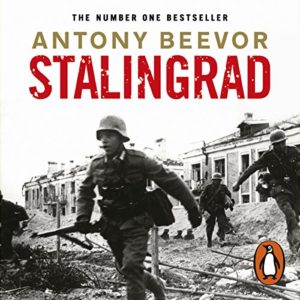
Pic Courtesy : Amazon
War is the most savage cruelty we inflict on each other and yet, perversely, war also pushes us to confront who we are; what it means to be human. The facade of civilisation is blown apart and we are left sifting through the debris, salvaging something; anything that we hope to piece together; so that we can reconstruct our sense of being human again.
What happened in Stalingrad is something well-nigh impossible to comprehend. If we did, we would not be the same. And yet, even as the account gets filtered through our fragile human defences – that seek to protect us from brutal truths- the implications are simply too powerful to sweep aside. There is a lot to search for within ourselves.
Where is Stalingrad and why was this battle so signficant?
Stalingrad, now Volgograd, was a city in the Soviet Union, that lies on the banks of the Volga river. In the Second World War, Hitler reneged on a no-aggression pact with the Soviet Union and invaded the Soviet Union. Germany’s spectacular military successes including the rapid fall of France, made Hitler believe in the infallibility of the German war-machine. Initially, Germany made rapid inroads and soon threatened Moscow itself. Somehow, the Soviets managed to hold onto Moscow. On their way to capturing the Soviet South where vast oilfields beckoned, the city of Stalingrad sat up on the war map. Strategically, it was not pivotal to German war objectives. And yet, Hitler saw a chance to upstage Stalin by winning a city that bore the Soviet leader’s name. This was after all, a confrontation between two all-powerful dictators. Hitler asked his army to take Stalingrad. Stalin picked up the gauntlet and swore not to lose Stalingrad.
The die was cast.
The Germans began by launching an air attack. And then the tanks and infantry moved in. The battle lasted for 5 months from August 1942 to February 1943. It wasn’t straightforward. The German 6th army, under Friedrich Paulus surrounded the city and barged in. The supporting German army units maintained logistical and military support to this 6th Army. They blocked the path for any massive troops that the Soviets might want to send in from the outside. The 62nd Army of Soviets was tasked with defending the city. Vasily Chuikov headed it and it was pushed back to select few strongholds within the city. The battle seemed to be lost for Stalin. The 62nd Army was being drip-fed with reinforcements, enough to resist; too less to push the Germans back.
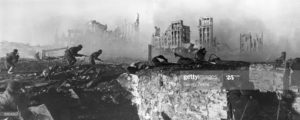
1942: Red Army troops storming an apartment block amidst the ruins of war-torn Stalingrad during World War II. This is a composite image. (Photo by Georgi Zelma/Slava Katamidze Collection/Getty Images)
And then, the winter set in. The change in season brought about a change in fortunes as well. Unknown to the Germans, the Soviets amassed troops and launched a massive counter-offensive. They fought their way through the supporting German army units and cut them off from the 6th Army that was fully ensconced in Stalingrad. The Hunter became the Hunted. The 6th army that had laid siege to the city was now itself surrounded by the Soviet forces that had encircled the city. Wintery conditions aggravated the situation for the Germans, who were now cut off from food, military supplies and rations. The Soviet 62nd army started getting an upperhand. The besieged Germans dug in their heels and even refused an offer to surrender. Finally, the Soviets brought enough force to bear on the situation. Stalingrad was firmly in Soviet hands. The 6th army of Paulus surrendered.
The total casualty? Mindnumbing. Total 2 million dead. 1.1 million Soviet and 8.6 lakh Germans.
Till the battle of Stalingrad, the Germans and Hitler were winning everywhere. Stalingrad changed everything. It turned out to be the turning-point of the Second World War. After Stalingrad, the Germans and Hitler never got anything right. They started losing. The War on the Eastern front, as the Soviet-German clash is called, was where the fiercest and bloodiest fighting took place. It was the Soviet Red army that defeated Germany and it has the numbers to show for it. 95% of the casualties of the Grand alliance ( UK, US, Soviet Union) were from the Soviet Union. 75% of total German military losses came at the hands of the Soviets. The Battle of Stalingrad is the most powerful reminder of the huge role played by the Soviet Union in the downfall of Hitler. A military success that turned things around, albeit at a tremendous human cost. That is why Stalingrad is so significant.
And what about the human cost? The misery it inflicted, the frailties in human nature that it exposed.
To begin with, all the German army needed to do was to block access to Volga to cut off Soviet supply routes. They could have done it anywhere along the route of Volga. Stalingrad was not required to do that. The military significance of Stalingrad ultimately boiled down to the personal significance that both Hitler and Stalin attached to control over the city. They showed utter disregard for the human lives that would be lost in the ensuing battle.
And they did not stop at issuing orders and taking a back seat, letting their generals do the rest.
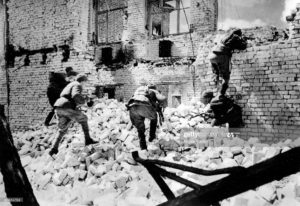
RUSSIA – OCTOBER 01: World War II. Russian soldiers at the battle of Stalingrad, September 1942 – February 1943. (Photo by Roger Viollet via Getty Images)
Hitler and Stalin, both sought to remote-control the moves of their armies. And the generals on both sides were severely hampered by this. However, for the Soviets, Georgy Zhukov seemed to have somehow managed to wriggle out key concessions from Stalin. Whereas Stalin laid down constraints and deadlines, Hitler micro-managed the waging of warfare to a ridiculous extent. For example, Hitler mandated that tankcrew had to step out and become a part of the frontline troops to finish the battle. When the battle plans changed, the tankcrew were left stranded and unable to reach their tanks.
On the other hand, Vasily Chuikov, who headed the 62nd army adapted his plan to ground-realities. Having seen the success of German blitzkrieg first-hand, he sought to nullify the german advantage. The blitzkrieg began with a massive airattack, followed by tanks, and infantry.
In Stalingrad, Chuikov decided to use the war-ruined terrain against the Germans.
Airattacks had reduced Stalingrad to a rubble. Chuikov improvised the notion of fighting units. 6-8 soldiers formed Storm-troops, one unit. This small unit used to get as close to the enemy as possible and then only start fighting. This way, the entire city was full of swirling street-battles where German and Soviet troops were so close to each other that the Luftwaffe (German air power) was taken out of the equation. They could not bomb from the air for fear of killing and wounding their own troops. The scattered ruins and heaps of rubble were perfect for creeping, crawling, hiding and springing up from nowhere to surprise the enemy. This same landscape was heaven for snipers who could use these urban contours for camouflage and inflict heavy damage on enemy troops.
The Soviets adapted.
Inspite of Soviet resilience, it was still hubris, more than anything, that got the Germans bogged down in Stalingrad. Be it Hitler or his Generals, everybody discounted the willpower of the Soviets and thought them to be lowly fighters. On the other hand, the Soviet people knew that this fight was a fight to the finish. Knowing that everything is at stake, the Soviets did not hesitate to draft in women as a part of their war-fighting plans. Close to 1 million Soviet women were drafted into military service during the Second World War, and half of them were in active combat! This is a remarkable statistic.
The grim realism of the Soviets made them ready themselves for the supreme sacrifice. Stalinist terror and dictatorship made it easy to marshall men, women, material, resources in anyway deemed fit without any internal opposition. This facilitated faster decisions and response times.
Hubris of Hitler and his generals made them double down on the things they already did if the initial plans didnt work. They didn’t catch onto the simple inference that if things did not work, the enemy had thwarted them. When you factor in a shrewd and capable enemy, you think better about all possibilities. In the initial months, the Germans simply intensified efforts without changing plans. They were forced to change only when adversity struck.
And then too, one crucial part of the equation for the generals was to sell their plans to Hitler. This resulted in deliberately vague and misleading communication about ground realities, all in an effort to curry favour and approval. Hitler responded in kind with grandiose orders that ran counter to war-fighting logic.
In a titanic battle, morale – protecting and raising it – becomes vital for military leaders. The German generals did not make a concerted effort on this front. More attention was paid to censoring soldiers letters so that the Nazi propaganda machine back home is not hamstrung by war truths.
The Soviet generals were ruthless in dealing with those who refused to fight or tried to escape. This was in keeping with Stalin’s order to force soldiers to fight. Even though this was the case, the Soviet troops were largely convinced that Nazi Germany was the greater evil. Once this was clear and the price of defeat was known to be total annihilation, they were ready to die.
For the Soviet leaders, it was clear that it was not just the Red army that was fighting the war, it was the Soviet people. In getting everybody involved, the morale was continuously nurtured.
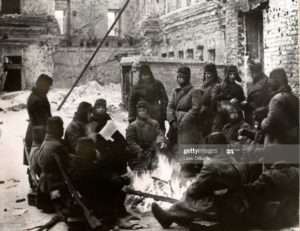
STALINGRAD, SOVIET UNION – 1942 / 1943: Battle of Stalingrad, one of major and strategically decisive battles of World War II, during which Nazi Germany forces fought the Soviet Union for control of Soviet city of Stalingrad from August 23, 1942 till February 2, 1943. (Photo by Laski Diffusion/Getty Images)
Stalingrad also showed how in a war, all norms and conventions are turned upside-down, everything is made subservient to the ultimate objective – prevailing over the enemy. This makes it possible for human-beings to perpetrate horrors that are unimaginable in a civilised world. War inflicts choices that do not feature good vs bad, it pits horrible vs the less horrible. And you choose horrible if it stands a better chance to achieve the objective. The less horrible choice exists to provide the illusion of having a choice.
Ultimately, all choices are made to get the upperhand in the fight. When the German troops were getting ready to storm Stalingrad, Stalin initially refused to let civilians evacuate. His brutal logic was that the troops would be more desperate to win if there are civilians to protect. And the civilians can pitch in as well. Eventually, the order was simplified. Anybody who has a hand that can take a rile will fight.
When the Germans started bombing the city, the civilians sought to flee across the Volga. The Soviet army did not give them priority. River transport access was commandered to facilitate the movement of fighting forces and weaponry.
Even among soldiers and civilains, the priority when it came to food was frontline soldiers. Those who fight get weapons and food first. However, things change when it comes to frontline troops and reinforcements. Front-line troops did not get new clothing, They were to replenish their stock by using the clothes of fallen comrades. The new reinforcements get top priority for new clothing.
Not just this, when the war became an endless round of street-battles and the harsh winter had set in, people caught up in the city were short of food. Desperate German soldiers used to bribe Soviet children with promises of food and ask them to venture across no-man’s land to the Volga river and fill water bottles . Soviet Soldiers had strict orders to shoot these children. Anybody helping the enemy, even if it be under duress, had to be shot.
In hospitals, the situation was very bad. Those with serious wounds were kept aside and left to die. The highest priority was to tend to the walking wounded. Anything that helps soldiers get back to fighting was done. Human life became an utterly calculable variable. Calculate the cost and pay it to win.
However, these colossal losses could have been cut short if German Generals could have broken free of the stranglehold of the Fuhrer’s words, seen the writing on the wall and decided to surrender. Indeed, the Soviet side had made an offer to the Germans. The Soviet emissary was not even allowed to meet Friedrich Paulus, the commander of the 6th Army.
The German army were fighting three enemies – the Winter, Hunger and the Red army. Paulus did try once to convey to Hitler how bad the situation was. He sent a decorated soldier, Captain Winrich Behr to personally brief Hitler. The assumption was that it is difficult to dismiss the message carried by a soldier feted for bravery.
When Behr went in, he had been told about Hitler’s tactics when a messenger brought bad news.
He always tried to control the conversation, imposing his version of events, and overwhelming his interlocutor, who knew only about a single sector of the front, with a powerful impression of the overall situation. This was exactly what happened.
When it was clear to everyone, even Hitler that the 6th army will have to surrender, he promoted Paulus to the position of Field Marshal. This was to motivate Paulus to fight to the finish and even commit suicide rather than surrender. To Hitler’s chagrin, Friedrich Paulus did not commit suicide. And surrendered. Hitler was upset about this. If Paulus would have done Hitler’s bidding, the Nazi propaganda machine would have used this as a way to stir the German people and call for even greater sacrifices for the Fatherland.
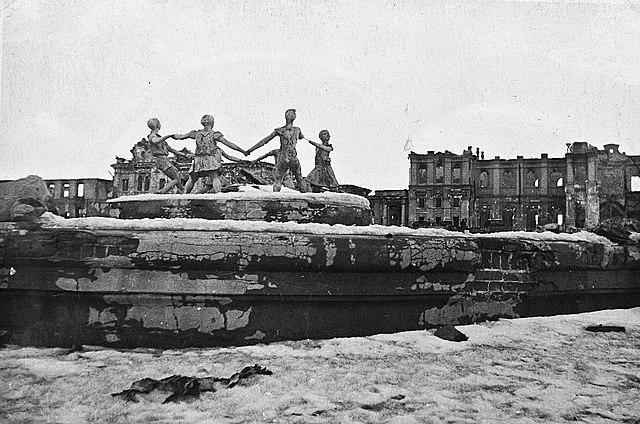
It is fitting to end with a passage from the book.
Very little that was recognizable remained from the city which had existed before Richthofen’s bombers appeared on that August afternoon. Stalingrad was now little more than a battered and burned skeleton. About the only landmark left standing was the fountain with statues of little boys and girls dancing around it. This seemed an unsettling miracle after so many thousands of children had persished in the ruins all around.
Out of the 994 surviving children at the end of this battle, only 9 were reunited with their parents.